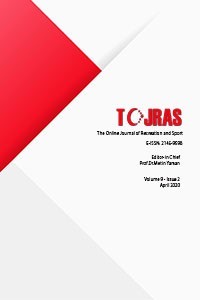THE EFFECTS OF NEUROTICISM ON APPROACH-AVOIDANCE-RELATED MOTOR BEHAVIOR
THE EFFECTS OF NEUROTICISM ON APPROACH-AVOIDANCE-RELATED MOTOR BEHAVIOR
Neuroticism, Approach-Avoidance motivation, MVC,
___
- REFERENCES Aubé, B., Rougier, M., Muller, D., Ric, F., & Yzerbyt, V. (2019). The online-VAAST: A short and online tool to measure spontaneous approach and avoidance tendencies. Acta Psychologica, 201(2019), 1-10. https://doi.org/10.1016/j.actpsy.2019.102942
- Britton, J. C., Ho, S.-H., Taylor, S. F., & Liberzon, I. (2007). Neuroticism associated with neural activation patterns to positive stimuli. Psychiatry Research: Neuroimaging, 156(3), 263–267. https://doi.org/10.1016/j.pscychresns.2007.06.003
- Burden, A. (2010). How should we normalize electromyograms obtained from healthy participants? What we have learned from over 25 years of research. Journal of Electromyography and Kinesiology, 20(6), 1023–1035. https://doi.org/10.1016/j.jelekin.2010.07.004
- Burden, A., & Bartlett, R. (1999). Normalisation of EMG amplitude: An evaluation and comparison of old and new methods. Medical Engineering & Physics, 21(4), 247–257. https://doi.org/10.1016/S1350-4533(99)00054-5
- Cacioppo, J. T., Priester, J. R., & Berntson, G. G. (1993). Rudimentary determinants of attitudes: II. Arm flexion and extension have differential effects on attitudes. Journal of Personality and Social Psychology, 65(1), 5-17. https://doi.org/10.1037/0022-3514.65.1.5
- Canli, T., Zhao, Z., Desmond, J. E., Kang, E., Gross, J., & Gabrieli, J. (2001). An fMRI study of personality influences on brain reactivity to emotional stimuli. Behavioral Neuroscience, 115(1), 33–42. https://doi.org/10.1037/0735-7044.115.1.33
- Cunningham, W. A., Arbuckle, N. L., Jahn, A., Mowrer, S. M., & Abduljalil, A. M. (2010). Aspects of neuroticism and the amygdala: chronic tuning from motivational styles. Neuropsychologia, 48(12), 3399–3404. https://doi.org/10.1016/j.neuropsychologia.2010.06.026
- De Luca, C. J. (1997). The use of surface electromyography in biomechanics. Journal of Applied Biomechanics, 13(2), 135–163. https://doi.org/10.1123/jab.13.2.135
- Elliot, A. J. (2006). The hierarchical model of approach-avoidance motivation. Motivation and Emotion, 30(2), 111–116. https://doi.org/10.1007/s11031-006-9028-7
- Elliot, A. J. (2008). Handbook of approach and avoidance motivation. New York: Psychology Press.
- Elliot, A. J., & Thrash, T. M. (2002). Approach-avoidance motivation in personality: Approach and avoidance temperaments and goals. Journal of Personality and Social Psychology, 82(5), 804-818. https://doi.org/10.1037/0022-3514.82.5.804
- Eysenck, H. J. (1967). The biological basis of personality. Springfield, IL: Thomas.
- Gomez, R., Gomez, A., & Cooper, A. (2002). Neuroticism and extraversion as predictors of negative and positive emotional information processing: Comparing Eysenck’s, Gray’s, and Newman’s theories. European Journal of Personality, 16(5), 333–350. https://doi.org/10.1002/per.459
- Lang, P. J., Bradley, M. M., & Cuthbert, B. N. (1997). International affective picture system (IAPS): Technical manual and affective ratings. NIMH Center for the Study of Emotion and Attention, 1(3), 39–58.
- Ng, W. (2009). Clarifying the relation between neuroticism and positive emotions. Personality and Individual Differences, 47(1), 69–72. https://doi.org/10.1016/j.paid.2009.01.049
- Önal-Hartmann, C., Pauli, P., Ocklenburg, S., & Güntürkün, O. (2012). The motor side of emotions: investigating the relationship between hemispheres, motor reactions and emotional stimuli. Psychological Research, 76(3), 311–316. https://doi.org/10.1007/s00426-011-0337-4
- Puca, R. M., Rinkenauer, G., & Breidenstein, C. (2006). Individual differences in approach and avoidance movements: How the avoidance motive influences response force. Journal of Personality, 74(4), 979–1014. https://doi.org/10.1111/j.1467-6494.2006.00400.x
- Razpurker-Apfeld, I., & Shamoa-Nir, L. (2021). Is an outgroup welcome with open arms? Approach and avoidance motor activations and outgroup prejudice. Journal of Experimental Psychology: Applied, 27(2), 417-429. https://doi.org/10.1037/xap0000334
- Rotteveel, M., & Phaf, R. H. (2004). Automatic affective evaluation does not automatically predispose for arm flexion and extension. Emotion, 4(2), 156-172. https://doi.org/10.1037/1528-3542.4.2.156
- Servaas, M. N., Van Der Velde, J., Costafreda, S. G., Horton, P., Ormel, J., Riese, H., & Aleman, A. (2013). Neuroticism and the brain: a quantitative meta-analysis of neuroimaging studies investigating emotion processing. Neuroscience & Biobehavioral Reviews, 37(8), 1518–1529. https://doi.org/10.1016/j.neubiorev.2013.05.005
- Sočan, G., & Bucik, V. (1998). Relationship between speed of information-processing and two major personality dimensions-extraversion and neuroticism. Personality and Individual Differences, 25(1), 35–48. https://doi.org/10.1016/S0191-8869(98)00031-2
- Tatar, A. (2016). The development of short-form five factor personality inventory. Anatolian Journal of Psychiatry, 17(1), 14-23. https://doi.org/10.5455/apd.202977
- Tok, S., Koyuncu, M., Dural, S., & Catikkas, F. (2010). Evaluation of International Affective Picture System (IAPS) ratings in an athlete population and its relations to personality. Personality and Individual Differences, 49(5), 461–466. https://doi.org/10.1016/j.paid.2010.04.020
- ISSN: 2146-9598
- Yayın Aralığı: Yılda 4 Sayı
- Başlangıç: 2012
- Yayıncı: METİN YAMAN
Miraç MAKUL, Murat KUL, Adem SOLAKUMUR
Spor Bilimleri Özel Yetenek Sınavına Katılan Bireylerde Kaygı
Mehmet SÖYLER, Raif ZİLELİ, Gürkan DİKER
PNF EGZERSİZLERİNİN VOLEYBOLCULARDA DENGE VE SIÇRAMA PERFORMANSI ÜZERİNE AKUT ETKİSİ VAR MIDIR?
Mehmet SARIKAYA, Nuray SATILMIŞ, İdris KAYANTAŞ, Gökmen KILINÇARSLAN, Akan BAYRAKDAR
2022 DÜNYA KUPASI’NDA BAĞIL YAŞ ETKİSİNİN İNCELENMESİ
THE EFFECTS OF NEUROTICISM ON APPROACH-AVOIDANCE-RELATED MOTOR BEHAVIOR
Erman DOĞAN, Serdar TOK, Şenol GÜVEN, Nihal DAL
